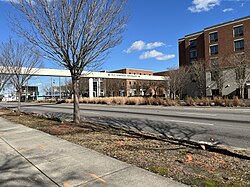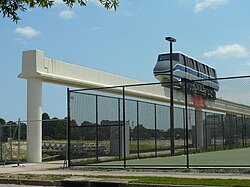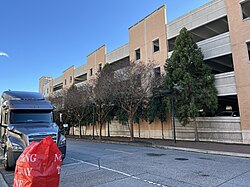
Personal rapid transit (PRT), also referred to as podcars or guided/railed taxis, is a public transport mode featuring a network of specially built guideways on which ride small automated vehicles that carry few passengers per vehicle. PRT is a type of automated guideway transit (AGT), a class of system which also includes larger vehicles all the way to small subway systems. In terms of routing, it tends towards personal public transport systems.

Transrapid is a German-developed high-speed monorail train using magnetic levitation. Planning for the system started in the late 1960s, with a test facility in Emsland, Germany inaugurated in 1983. In 1991, technical readiness for application was approved by the Deutsche Bundesbahn in cooperation with renowned universities.

Old Dominion University (ODU) is a public research university in Norfolk, Virginia. Established in 1930 as the two-year Norfolk Division of the College of William & Mary, it began by educating people with fewer financial assets in the Norfolk-Virginia Beach area of the Hampton Roads region. Later Virginia Polytechnic Institute also began offering classes for the Division. The Division became independent from William and Mary in 1962 and has since expanded into a residential college for traditional students and is one of the largest universities in Virginia with an enrollment of 23,494 students for the 2023 academic year. The university also enrolls over 600 international students from 99 countries. Its main campus covers 250 acres (1.0 km2) straddling the city neighborhoods of Larchmont, Highland Park, and Lambert's Point, approximately five miles (8.0 km) north of Downtown Norfolk along the Elizabeth River.

An automated guideway transit (AGT) or automated fixed-guideway transit or automatic guideway transit system is a type of fixed guideway transit infrastructure with a riding or suspension track that supports and physically guides one or more driverless vehicles along its length. The vehicles are often rubber tired or steel wheeled, but other traction systems including air cushion, suspended monorail and maglev have been implemented. The guideway provides both physical support, like a road, as well as the guidance. An automated line can be cheaper to run than a conventional line, due to the shorter trains and stations.

Maglev is a system of rail transport whose rolling stock is levitated by electromagnets rather than rolled on wheels, eliminating rolling resistance.
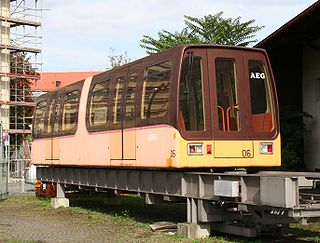
The M-Bahn or Magnetbahn was an elevated Maglev train line operating in Berlin, Germany, experimentally from 1984 and in passenger operation from 1989 to 1991. The line was 1.6 kilometres (1 mi) in length, and featured three stations, two of which were newly constructed. Presumed to be the future of rail transit in Berlin, the line was built to fill a gap in the West Berlin public transport network created by the construction of the Berlin Wall. It was rendered redundant by the reunification of Berlin and was closed to enable reconstruction of the U2 line. It was Europe's only operational maglev line.
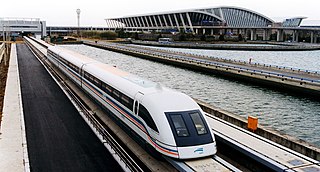
The Shanghai maglev train (SMT) or Shanghai Transrapid is a magnetic levitation train (maglev) line that operates in Shanghai, China. The line uses the German Transrapid technology. The Shanghai maglev is the world's first commercial high-speed maglev and has a maximum cruising speed of 300 km/h (186 mph). Prior to May 2021 the cruising speed was 431 km/h (268 mph), at the time this made it the fastest train service in commercial operation.

The Aérotrain was an experimental Tracked Air Cushion Vehicle (TACV), or hovertrain, developed in France from 1965 to 1977 under the engineering leadership of Jean Bertin (1917–1975) – and intended to bring the French rail network to the cutting edge of land-based public transportation.

The SCMaglev is a magnetic levitation (maglev) railway system developed by Central Japan Railway Company and the Railway Technical Research Institute.
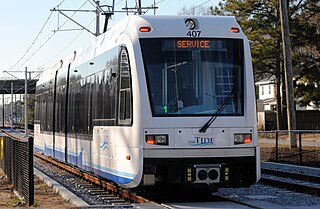
The Tide is a 7.4 mi (12 km) light rail line in Norfolk, Virginia, United States, owned and operated by Hampton Roads Transit (HRT). It connects Eastern Virginia Medical School, downtown Norfolk, Norfolk State University, and Newtown Road. Service began on August 19, 2011, making it the first light rail system in Virginia. Fares match local bus fares and the line accepts HRT's GO Passes. Trains generally run every 15 minutes, increasing to every 10 minutes during peak periods and every 30 minutes during early mornings and late evenings. In 2023, the system had a ridership of 771,500, or about 2,500 per weekday as of the third quarter of 2024.

The Old Dominion Monarchs football program represents Old Dominion University in U.S. college football. The first iteration of the team created in 1930 was known as the William & Mary Norfolk Division Braves. Founded in 2009, the current Monarchs team competed as an FCS independent for their first two seasons. In the 2011 season, they joined the Colonial Athletic Association and added conference games to their schedule, playing there until joining the Conference USA of the FBS in 2014. They joined the Sun Belt Conference in 2022.

Skytran is a personal rapid transit system concept. It was first proposed by the inventor Douglas Malewicki in 1990 and was under development by Unimodal Inc. A prototype of the skyTran vehicle and a section of track have been constructed. The early magnetic levitation system, Inductrack, which SkyTran has replaced with a similar proprietary design, has been tested by General Atomics with a full-scale model. In 2010, Unimodal signed an agreement with NASA to test and develop skyTran. skyTran had proposed additional projects in France, Germany, India, Indonesia, Malaysia, the United Kingdom, and the United States.
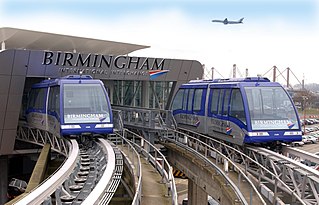
The Air-Rail Link is a people mover linking Birmingham Airport with Birmingham International railway station and the National Exhibition Centre in England. The current system, originally known as SkyRail, replaced the earlier Birmingham Maglev system in 2003.
ROMAG was a personal rapid transit (PRT) system produced by the American company Rohr, Inc. It featured a linear induction motor that was arranged to provide both traction and suspension in a magnetic levitation system.

Tracked Hovercraft was an experimental high-speed train developed in the United Kingdom during the 1960s. It combined two British inventions, the hovercraft and the linear induction motor, in an effort to produce a train system that would provide 250 mph (400 km/h) inter-city service with lowered capital costs compared to other high-speed solutions. Substantially similar to the French Aérotrain and other hovertrain systems of the 1960s, Tracked Hovercraft suffered a fate similar to those of the other projects when it was cancelled as a part of wide budget cuts in 1973.
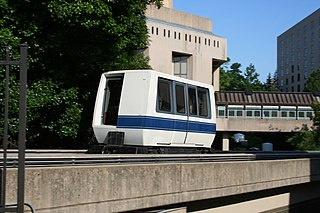
A hovertrain is a type of high-speed train that replaces conventional steel wheels with hovercraft lift pads, and the conventional railway bed with a paved road-like surface, known as the track or guideway. The concept aims to eliminate rolling resistance and allow very high performance, while also simplifying the infrastructure needed to lay new lines. Hovertrain is a generic term, and the vehicles are more commonly referred to by their project names where they were developed. In the UK they are known as tracked hovercraft, in the US they are tracked air-cushion vehicles. The first hovertrain was developed by Jean Bertin in the early 1960s in France, where they were marketed as the Aérotrain before being abandoned by the French government.
Krauss-Maffei's Transurban was a 12-passenger automated guideway transit (AGT) mass transit system based on a maglev guideway. Development started in 1970 as one of the many AGT and PRT projects that followed in the wake of the HUD reports of 1968. Its selection as the basis of the GO-Urban system in Toronto in 1973 made it well known in the industry; it would have been the basis of the first large-area AGT mass transit network in the world. Technical problems cropped up during the construction of the test track, and the sudden removal of funding by the West German government led to the project's cancellation in late 1974. The Ontario government completed development and installation of a non-maglev version, today known as the Bombardier Advanced Rapid Transit.

The L0 Series is a high-speed maglev train which the Central Japan Railway Company has been developing and testing. JR Central plans to use the L0 series on the Chūō Shinkansen railway line between Tokyo and Osaka, which is under construction.
American Maglev Technology (AMT), sometimes referred to as just American Maglev, is an American company founded in 1994 focused on creating maglev systems for public transit based in Amelia Island, Florida with former locations in Mariette, Georgia, and in Volusia County, Florida. It is led by CEO, Tony Morris and vice president Jordan Morris. The company has a working maglev test track located in Powder Springs, Georgia and formerly had one in Volusia County, Florida before moving locations. The company has invested more than $50 million into its research and development projects.

